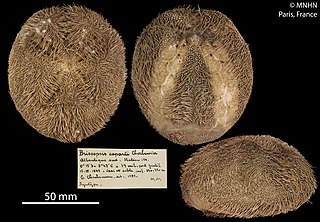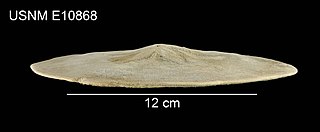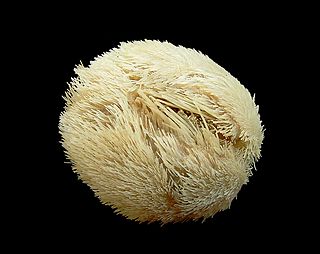
The Echinacea are a superorder of sea urchins. They are distinguished by the presence of a rigid test, with ten buccal plates around the mouth, and solid spines. Unlike some other sea urchins, they also possess gills. The group is a large one, with species found worldwide.

Clypeaster, common name "cake urchins" or "sea biscuits", is a genus of echinoderms belonging to the family Clypeasteridae.

Brissopsis caparti is a species of sea urchins of the family Brissidae. Their armour is covered with spines. Brissopsis caparti was first scientifically described in 1959 by Cherbonnier.

Brissopsis lyrifera is a species of sea urchins of the family Brissidae. Their armour is covered with spines. It was first described by the British naturalist Edward Forbes in 1841. This species of sea urchin is a nonselective, infaunal deposit feeder.
Cionobrissus revinctus is a species of sea urchins of the Family Brissidae. Their armour is covered with spines. Cionobrissus revinctus was first scientifically described in 1879 by Alexander Emanuel Agassiz.
Clypeaster amplificatus is a species of sea urchins of the family Clypeasteridae. Their armour is covered with spines. Clypeaster amplificatus was first scientifically described in 1922 by Koehler.
Clypeaster annandalei is a species of sea urchins of the family Clypeasteridae. Their armour is covered with spines. Clypeaster annandalei was first scientifically described in 1922 by Koehler.

Clypeaster australasiae, the Australasian sand dollar, is a species of sea urchins of the family Clypeasteridae. Their armour is covered with spines. Clypeaster australasiae was first scientifically described in 1851 by Gray.

Clypeaster chesheri is a species of sea urchins of the family Clypeasteridae. Their armour is covered with spines. Clypeaster chesheri was first scientifically described in 1970 by Serafy.

Clypeaster cyclopilus is a species of sea urchins of the family Clypeasteridae. Their armour is covered with spines. Clypeaster cyclopilus was first scientifically described in 1941 by Hubert Lyman Clark.
Clypeaster durandi is a species of sea urchins of the Family Clypeasteridae. Their armour is covered with spines. Clypeaster durandi was first scientifically described in 1959 by Cherbonnier.
Clypeaster elongatus is a species of sea urchins of the family Clypeasteridae. Their armour is covered with spines. Clypeaster elongatus was first scientifically described in 1948 by Hubert Lyman Clark.

Clypeaster euclastus is a species of sea urchins of the family Clypeasteridae. Their armour is covered with spines. Clypeaster euclastus was first scientifically described in 1941 by Hubert Lyman Clark.

Irregularia is an extant infraclass of sea urchins that first appeared in the Lower Jurassic.

Clypeaster reticulatus, the reticulated sea biscuit, is a species of sea urchin in the family Clypeasteridae. This species was first scientifically described in 1758 by Carl Linnaeus. It lives on the sandy seabed of shallow seas, semi-immersed in the sediment.

Clypeasteridae is a family of sea urchins in the order Clypeasteroida. This family was first scientifically described in 1835 by the Swiss-American biologist Louis Agassiz.

Clypeaster rosaceus, the fat sea biscuit, is a species of sea urchin in the family Clypeasteridae. It occurs in shallow water in the western Atlantic Ocean and was first scientifically described in 1758 by Carl Linnaeus.

Clypeaster humilis is a species of sea urchin in the family Clypeasteridae. This species was first scientifically described in 1778 by the German biologist Nathanael Gottfried Leske. It occurs in the tropical Indo-Pacific region.

Clypeaster japonicus, the Japanese sea biscuit, is a species of sea urchin in the family Clypeasteridae. This species was first scientifically described in 1885 by the German zoologist Ludwig Heinrich Philipp Döderlein.

Clypeaster subdepressus is a species of sea urchin in the family Clypeasteridae. This species was first scientifically described in 1825 by the British zoologist John Edward Gray. It is a very large and flattened sea biscuit, native to the east coasts of North, Central and South America.













